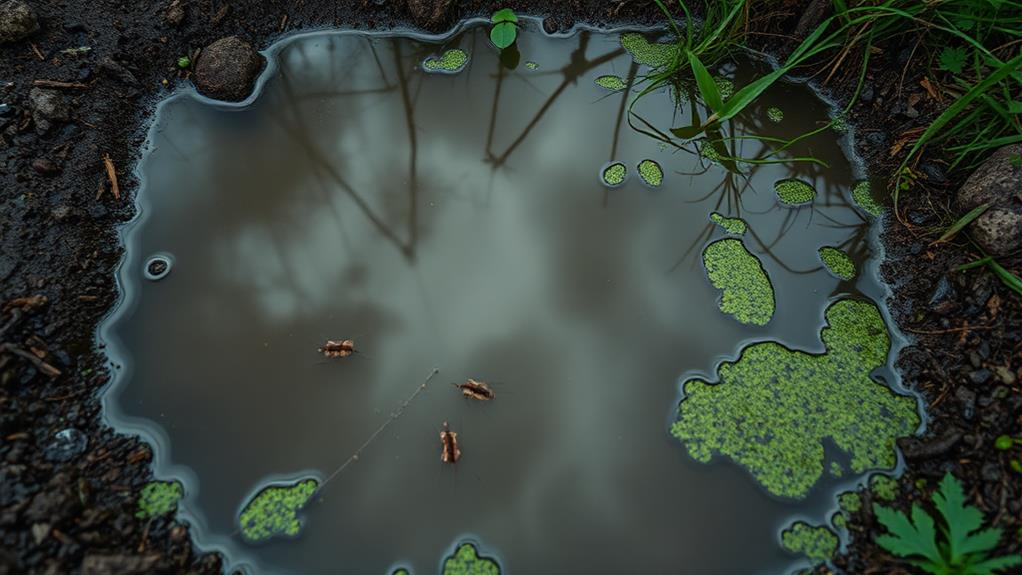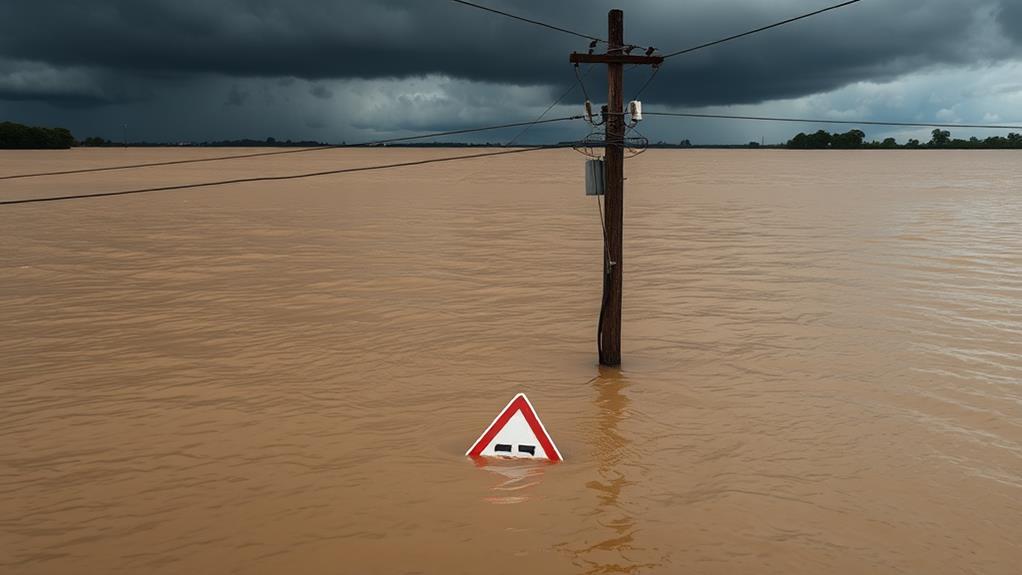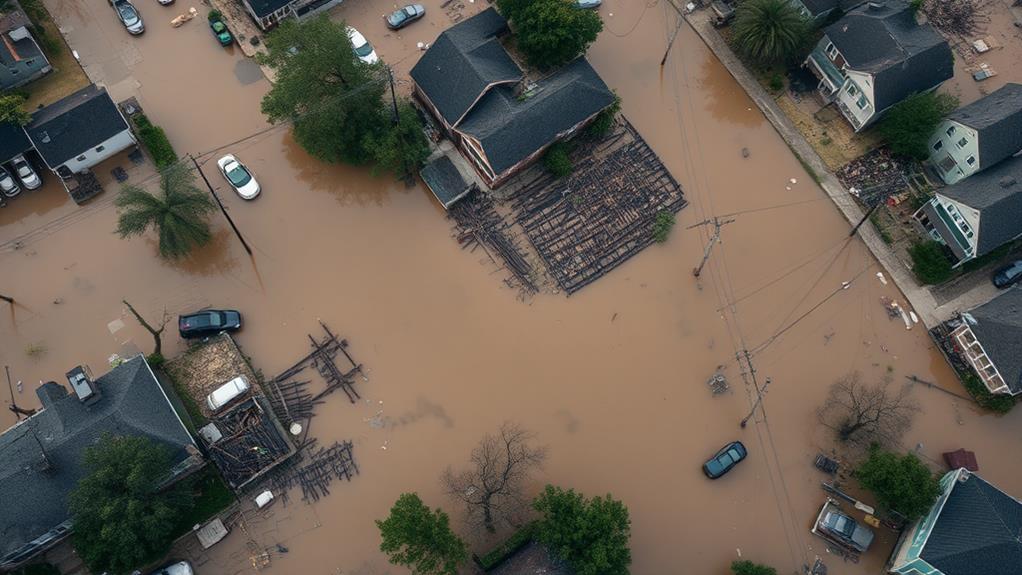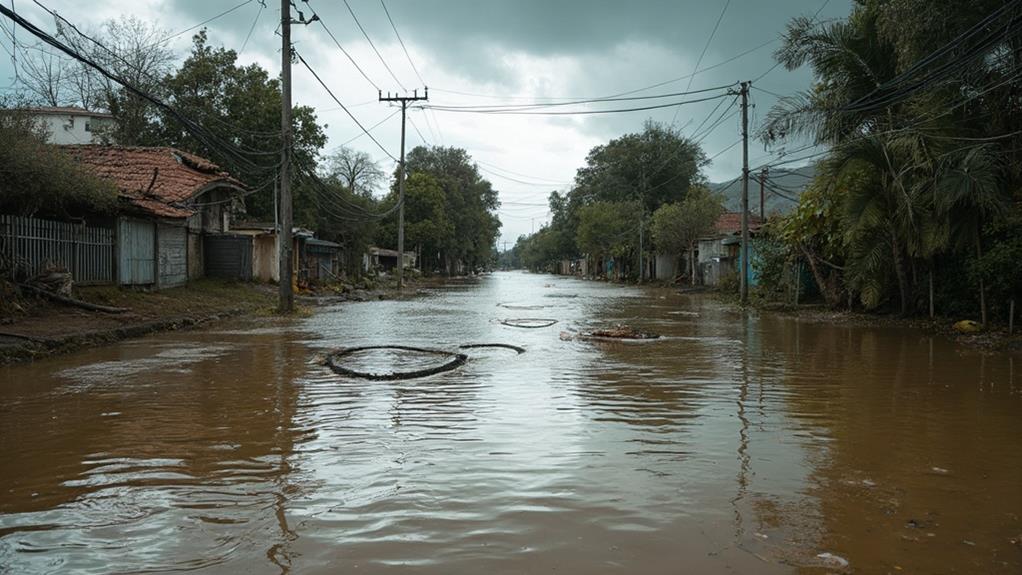Post-storm standing water conceals numerous hazards that threaten public health and safety. Disease-causing microorganisms like bacteria, viruses, and parasites thrive in these stagnant pools. Chemical contaminants from industrial sources, agricultural runoff, and household materials pose additional risks. Electrocution dangers exist due to submerged electrical equipment and downed power lines. Displaced wildlife, including venomous snakes and large mammals, present unexpected threats. Moreover, prolonged water exposure can lead to structural damage, mold growth, and environmental degradation. Understanding these hidden dangers is crucial for safely navigating post-storm environments and mitigating potential risks.
Disease-Causing Microorganisms

Waterborne pathogens pose significant health risks in post-storm standing water. These microscopic organisms, including bacteria, viruses, and parasites, thrive in stagnant pools left behind by floods and heavy rainfall. Common pathogens found in these waters include E. coli, Salmonella, Giardia, and Cryptosporidium. These microorganisms can cause a range of illnesses, from mild gastrointestinal distress to severe infections that may require hospitalization.
The contamination of standing water often results from sewage overflows, agricultural runoff, and animal waste. As floodwaters recede, they leave behind concentrated pockets of these pathogens, creating ideal breeding grounds for disease transmission. People who come into contact with contaminated water through ingestion, skin contact, or inhalation of water droplets are at risk of infection.
Symptoms of waterborne illnesses may include diarrhea, vomiting, fever, and skin rashes. Certain populations, such as children, the elderly, and immunocompromised individuals, are particularly vulnerable to these infections. To mitigate risks, it is crucial to avoid contact with standing water whenever possible and to practice proper hygiene, including thorough handwashing, after potential exposure.
Chemical Contaminants
While biological pathogens pose significant health risks, standing water also harbors various chemical contaminants that can be equally hazardous. Floodwaters often mix with industrial chemicals, petroleum products, and household hazardous materials, creating a toxic soup. Common contaminants include pesticides, fertilizers, and heavy metals like lead and mercury.
These chemicals can enter the water from damaged storage facilities, flooded garages, or agricultural runoff. Oil and gasoline from submerged vehicles contribute to the contamination, as do cleaning products and solvents from homes and businesses. In urban areas, standing water may contain high levels of pollutants from overwhelmed sewage systems and storm drains.
Exposure to these chemical contaminants can occur through skin contact, ingestion, or inhalation of water droplets. Health effects range from mild irritation to severe poisoning, depending on the type and concentration of chemicals present. Long-term exposure may lead to chronic health issues, including respiratory problems, organ damage, and increased cancer risk. To mitigate these dangers, it's crucial to avoid contact with standing water whenever possible and to follow proper decontamination procedures if exposure occurs.
Electrocution Risks

One of the most insidious dangers lurking in post-storm standing water is the risk of electrocution. Floodwaters can conceal downed power lines, submerged electrical equipment, and damaged wiring from nearby buildings. These hidden electrical hazards pose a significant threat to anyone who comes into contact with the water.
The conductivity of water, especially when contaminated with minerals and debris, amplifies the risk of electrical shock. Even low-voltage currents can be fatal when transmitted through standing water. Emergency responders, cleanup crews, and residents returning to flooded areas are particularly vulnerable to this danger.
To mitigate electrocution risks, it's crucial to avoid entering floodwaters whenever possible. If entry is necessary, rubber boots and insulated gloves should be worn. Before attempting to navigate flooded areas, local authorities should be consulted to ensure power has been cut to affected regions. Additionally, portable electrical equipment should never be used near standing water.
Professionals tasked with restoring power must exercise extreme caution, employing specialized equipment and following strict safety protocols. Public awareness campaigns can help educate communities about the invisible but potentially lethal electrical hazards present in post-storm environments.
Displaced Wildlife Hazards
Displaced by rising floodwaters, wildlife poses a significant hazard in post-storm environments. Animals seeking refuge from inundated habitats often find themselves in unfamiliar urban or residential areas, increasing the likelihood of human-wildlife encounters. Snakes, alligators, and other potentially dangerous creatures may be found in standing water or debris piles, presenting risks to unsuspecting individuals.
Venomous snakes, such as cottonmouths and copperheads, are of particular concern in flood-prone regions. These reptiles are excellent swimmers and may be more aggressive when stressed by displacement.
Large mammals like deer or wild boars, disoriented by flooding, can cause traffic accidents or property damage as they search for dry ground.
Rodents and other small mammals fleeing floodwaters may carry diseases such as leptospirosis or hantavirus. Their presence in populated areas increases the risk of disease transmission to humans and pets. Additionally, insects like fire ants can form floating rafts in floodwaters, posing a threat to anyone who comes into contact with them.
To mitigate these risks, residents and recovery workers should remain vigilant, wear appropriate protective gear, and avoid direct contact with standing water or debris whenever possible.
Structural and Environmental Damage

The aftermath of severe storms often leaves behind a wake of structural and environmental devastation. Standing water can exacerbate these issues, causing further damage to already compromised structures and ecosystems. Floodwaters can weaken building foundations, erode soil, and create sinkholes, posing serious risks to both residential and commercial properties. The prolonged presence of water can lead to mold growth, wood rot, and corrosion of metal components, compromising the integrity of buildings and infrastructure.
Environmentally, standing water can have far-reaching consequences. It can contaminate soil and groundwater with pollutants, chemicals, and sewage, potentially affecting drinking water sources and agricultural land. Erosion caused by floodwaters can alter landscapes, damage habitats, and disrupt local ecosystems. Stagnant water bodies become breeding grounds for mosquitoes and other disease-carrying insects, posing public health risks. Additionally, the decomposition of organic matter in standing water can release harmful gases and contribute to air pollution. The cumulative effect of these structural and environmental damages can have long-lasting impacts on communities, requiring extensive remediation efforts and potentially altering the local landscape for years to come.
Frequently Asked Questions
How Long Does Standing Water Typically Remain After a Storm?
The duration of standing water after a storm varies depending on factors such as rainfall intensity, drainage systems, soil composition, and topography. It can range from a few hours to several days or even weeks in some cases.
Can I Use Water Purification Tablets to Make Standing Water Safe?
Water purification tablets can be effective in treating standing water, but they may not eliminate all contaminants. While they can kill many harmful microorganisms, they won't remove chemical pollutants or debris. Additional filtration methods are often necessary for complete safety.
Are There Any Visual Indicators of Dangerous Contaminants in Standing Water?
Picture a murky puddle after a storm. While some contaminants may be visible, like debris or oily sheen, many dangerous pollutants aren't detectable by sight alone. Color, odor, or floating matter can indicate issues, but professional testing is recommended for certainty.
What Protective Gear Should I Wear When Dealing With Post-Storm Water?
When dealing with post-storm water, wear waterproof boots, gloves, and goggles. Use protective clothing that covers exposed skin. Consider respiratory protection if there's a risk of airborne contaminants. Ensure all gear is properly fitted and in good condition.
How Can I Safely Remove Standing Water From My Property?
Like a meticulous surgeon, approach standing water removal with caution. Use pumps or wet vacuums for large areas. For smaller puddles, employ absorbent materials or sweep into drains. Always wear protective gear and avoid direct contact with contaminated water.
Conclusion
Like a siren's deceptive call, post-storm standing water conceals multifaceted perils beneath its placid surface. This modern-day Pandora's box harbors microscopic foes, toxic elixirs, and electric serpents waiting to strike. Nature's displaced creatures seek refuge in these temporary oases, while structural foundations crumble silently below. As the floodwaters recede, they leave behind a landscape forever altered, both visibly and invisibly. Vigilance and caution become the torch to navigate this treacherous aftermath.

